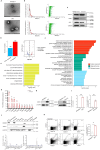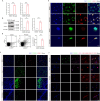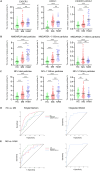CX3CR1+/UCHL1+ microglial extracellular vesicles in blood: a potential biomarker for multiple sclerosis
- PMID: 39385200
- PMCID: PMC11465848
- DOI: 10.1186/s12974-024-03243-z
CX3CR1+/UCHL1+ microglial extracellular vesicles in blood: a potential biomarker for multiple sclerosis
Abstract
In neuroinflammation, distinguishing microglia from macrophages and identifying microglial-specific biomarkers in peripheral blood pose significant challenges. This study comprehensively profiled the extracellular vesicles (EVs) of microglia and macrophages, respectively, revealing co-expressed EVs with UCHL1 and CX3CR1 as EVs derived specifically from microglia in human blood. After extensive validation, using optimized nano flow cytometry, we evaluated plasma CX3CR1+/UCHL1+ EVs across clinical cohorts [multiple sclerosis (MS), HTLV-1 associated myelopathy (HAM), Alzheimer's disease (AD), and Parkinson's disease (PD)], along with established neurodegenerative markers (NMDAR2A and NFL). The findings discovered a notable rise in CX3CR1+/UCHL1+ EVs in MS, particularly heightened in HAM, in contrast to controls. Conversely, AD and PD exhibited unaltered or diminished levels of microglial EVs. An integrated model of CX3CR1+/UCHL1+, NMDAR2A+, and NFL+ EVs demonstrated promising diagnostic potential for distinguishing MS from controls and HAM. As to the disease duration, CX3CR1+/UCHL1+ EVs increased in the initial five years of MS, stabilizing thereafter, whereas NMDAR2A+ and NFL+ EVs remained stable initially but increased significantly in the subsequent five years, suggesting their correlation with disease duration. This study uncovers unique blood microglial EVs with potential as biomarkers for MS diagnosis, differentiation from HAM, and correlation with disease duration.
Keywords: Biomarker; CX3CR1; Extracellular vesicles; Microglia; Multiple sclerosis; UCHL1.
© 2024. The Author(s).
Conflict of interest statement
The authors declare no competing interests.
Figures





References
MeSH terms
Substances
Grants and funding
LinkOut - more resources
Full Text Sources
Medical
Research Materials
Miscellaneous

